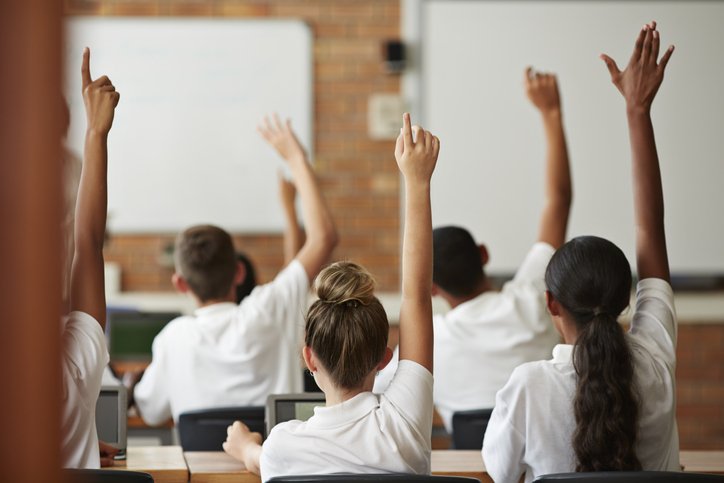Absence rates will stay high until the Covid-19 generation leaves secondary school
Pupil absence in secondary schools will remain above pre-pandemic levels, at least until those who began secondary school during the pandemic have left school, a new report from the London School of Economics (LSE) in collaboration with the University of Surrey has found.

The pandemic, pupil attendance and achievement report is published by the LSE’s Centre for Economic Performance in collaboration with the University of Surrey and is funded by the Nuffield Foundation. It finds that the high levels of pupil absence in England seen since the Covid-19 pandemic can be linked to a shift in attitudes towards school attendance at the time.
The researchers show how absence rates for the 3.7m pupils in their sample doubled after the pandemic. In the autumn terms before the pandemic, around 3.6% of half-day sessions were missed. In the autumn of 2020, overall absence rates had risen to 13.5% of sessions missed – the majority of these (8.7%) were “forced” absences, due to children not being allowed to come to school after coming into contact with someone who had tested positive for Covid. (Children missing school due to having Covid themselves were excluded from the analysis due to small numbers). But “unforced” absences for reasons unconnected to Covid also rose – to a rate of 5.6% of remaining sessions missed.
By the autumn of 2021, “forced” absences had dropped to 1.7% but the rate of “unforced” absence was 7.7% and that higher rate of absence persisted.
The research finds that while the absence rates of children who were primary school pupils in the autumn of 2020 have now returned to near pre-pandemic levels, the absence rates for those already in secondary school that autumn are likely to remain higher until they leave school.
The research also shows that pupil absence during the pandemic was strongly linked to socio-economic factors, with those at schools in disadvantaged areas missing out the most.
Disadvantaged children were also more likely to be persistently absent one year later, potentially widening the gaps in educational achievement.
The authors stress that these knock-on effects from government restrictions during the pandemic are in addition to any direct effects of the pandemic and school closures during 2020 and 2021.
“Although it appears that school closures during the pandemic are relevant, this is only part of the story of continuing high pupil absence rates – and perhaps not the main part – with changing attitudes and an increased incidence of mental health issues such as anxiety playing a role. The focus should now be on trying to reduce school absences,” said co-author Professor Stephen Gibbons.
The research examined two periods during the pandemic when schools in England were not in national lockdown and policies on school opening varied across the country: June 2020 when reopening began after the first national lockdown and the autumn of 2020 when schools were mostly open (apart from a two-week national lockdown) but tier regulations meant differing restrictions on social and business activity across the country.
This allowed the researchers to compare how the different policies affected children with similar backgrounds.
They find that:
- Pupils in higher tiers were more likely to be absent than those in the lowest, and pupils from lower socio-economic groups were much more strongly affected. Tighter restrictions (not directly affecting schools) led to a half-day absence on average for a pupil in the least deprived area but 2.25-day absence for a pupil in the most deprived area.
- Persistent absence – defined as missing at least 10% of sessions, equivalent to one day every fortnight – has risen dramatically. The numbers missing one day a fortnight quadrupled between 2019 and 2021 (from 8% to 34%) and the proportion missing two days a week (40% of sessions) was more than 10 times higher, (from 0.2% to 2.3%).
The report also highlights the impact of the pandemic on school achievement. While the changes in the way GCSEs were assessed during the pandemic make it difficult to reliably measure the impact on 15 and 16year-olds, pupils who were at primary school were clearly affected.
Government statistics show that between 2018/19 and 2021/22, the percentage of 10 and 11-year-olds reaching the expected level in their key stage 2 tests taken at the end of primary school, fell from 79% to 71% in maths and 78% to 72% in grammar, punctuation and spelling (GPS). Reading seemed largely unaffected with 73-75% of pupils reaching the expected levels both before and after. The researchers calculate the effect of absence and lost schooling time on achievement.
They put primary pupils into 100 bands – from the top 1% to bottom 1% – known as percentiles. The analysis suggests that tier regulations came at an average cost of around 1.6 percentiles of achievement in maths and GPS, and 0.5 percentiles in reading at the end of primary school. The report concludes that local pandemic policies had differing effects on absences across groups of pupils, and was particularly significant for disadvantaged pupils.
This also feeds through into persistent absence a year later. The findings suggest that the socio-economic gap in educational achievement has, and will continue, to widen and shows that those needing most assistance to recover from the effects of Covid-19 are those from under-privileged backgrounds.
Professor Gibbons, Professor of Economic Geography, at LSE said:
“It is likely that there was a shift in family attitudes to attendance during the autumn term of 2020, induced by the local public health policies, social and work restrictions of the time, that has persisted post-pandemic. Being prohibited from attending school in itself seems to have had little lasting impact.”
Professor Sandra McNally, Professor of economics at the University of Surrey, added:
“Even though absences are more prevalent in secondary school than in primary school, the effect of variation in policy restrictions comes out more strongly in subsequent primary school attainment at age 11. This may be because of measurement problems in GCSEs or it may be because variation in policy restrictions really did have a more severe impact on younger pupils. “We cannot know for sure whether these results directly reflect the impact of pandemic policies on absences (which in turn influenced test scores) or whether they reflect the indirect effect of these policies on children’s mental health or family finances, which could influence future achievement without affecting attendance at school. The data on primary school pupils suggest that the educational effects of Covid-19 will persist unless policies are introduced to counter the consequences of pandemic-induced learning loss.”
Josh Hillman, Director of Education at the Nuffield Foundation said:
“Good attendance at school is one of the key drivers of educational outcomes, so it is very worrying to see high absence rates persisting long after the end of the pandemic, with disadvantaged children significantly more likely to be missing school, thus widening the achievement gap. This report should act as an important prompt for government to ensure strategies are put in place to support pupils to be at school, and that they remain for as long as they are needed.”
Read the overview report: The pandemic, pupil attendance and achievement
Read discussion paper: Pupil absence and the pandemic
Read discussion paper: Absence and attainment: evidence from pandemic policy
Notes to editors
1. This research was funded by the Nuffield Foundation grant number FR-000022949.
We are grateful to the Nuffield Foundation for funding this research and to members of the advisory group set up to support this project.
This work was undertaken in the Office for National Statistics Secure Research Service using data from ONS and other owners and does not imply the endorsement of the ONS or other data owners.
2. The Nuffield Foundation is an independent charitable trust with a mission to advance social wellbeing. It funds research that informs social policy, primarily in Education, Welfare, and Justice. The Nuffield Foundation is the founder and co-funder of the Nuffield Council on Bioethics, the Ada Lovelace Institute and the Nuffield Family Justice Observatory. The Foundation has funded this project, but the views expressed are those of the authors and not necessarily the Foundation. Website: ww.nuffieldfoundation.org Twitter: @NuffieldFound
3. The Centre for Economic Performance (CEP) is an independent research centre based at the London School of Economics and Political Science. Its members are from the LSE, University of Surrey and a wide range of universities within the UK and around the world.
4. The Centre for Economic Performance is part-funded by the Economic and Social Research Council, part of UK Research and Innovation (UKRI).
5. About the authors:
- Stephen Gibbons is a professor of economic geography and head of department at the Department of Geography and Environment, LSE. He is a research associate in CEP’s education and skills, and urban programmes.
- Sandra McNally is a professor of economics at the University of Surrey and director of CEP’s education and skills programme.
- Piero Montebruno worked as a post-doctoral researcher in the Centre for Economic Performance, LSE up to September 2023.
6. For more information contact: mediarelations@surrey.ac.uk
Related sustainable development goals

Media Contacts
External Communications and PR team
Phone: +44 (0)1483 684380 / 688914 / 684378
Email: mediarelations@surrey.ac.uk
Out of hours: +44 (0)7773 479911
